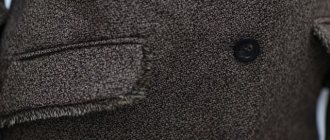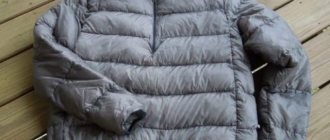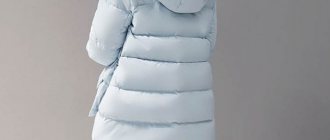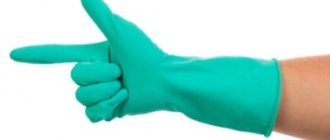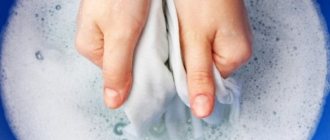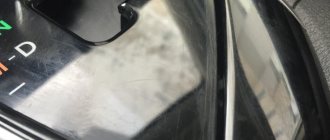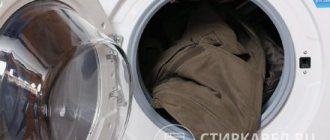Useful tips for dry cleaning a down jacket at home without washing
Dry cleaning of a down jacket is a local cleaning of dirt or stains without the use of hand or machine washing.
This option for getting rid of dirt allows you to quickly get a clean down jacket or jacket, saving time on drying.
In addition, dry cleaning does not affect the entire down jacket, as happens during washing. This allows you to extend the life of the product. In this article we will look at the process of dry cleaning a down jacket at home without washing.
LiveInternetLiveInternet
Quote from Alinochka_Luneva's message
Read in full In your quotation book or community!
How to remove a stain. 20 ways to remove any stain!
First you need to figure out what was planted with and how deep the stain penetrated. Stains can be greasy or non-greasy. Fat stains from milk, butter, blood, soups, meat, fish and so on - the contours are fuzzy, at first darker than the fabric, and then fades. Fruit, wine, beer, tea and coffee stains have clear boundaries, with a lighter stain in the middle. Many stains oxidize when exposed to air. Determine what kind of fabric you have in front of you; usually the composition is indicated on a tag sewn on the inside.
Stain remover arsenal. Alcohol, baking soda, dish soap, ammonia, vinegar, starch, acetone, gasoline, citric acid, glycerin, turpentine (tiner) and hydrogen peroxide. A pipette, brushes of varying softness, pieces of sponge and clean cotton rags (can be cut from unwanted clothes). All this can be purchased at a pharmacy or the nearest hardware store. Dangers of stain removal. · 1. Stain removers, like medicines, have side effects, so you need to try them on an invisible piece. · 2. Industrial stain removers, such as Sano Oxygen, Potassium and others like them, leave permanent stains if left on clothing and allowed to dry. So we sprayed it, waited a couple of minutes, and into the water. · 3. Do not use bleach (economy), not only does it have a harmful effect on health and cause mutations in genes, it also destroys the structure of cotton fabric and leaves a terrible smell. · 4. Any solvent can dissolve paint on clothing. · 5. Acetate silk dissolves in acetone and vinegar. · 6. Bleaching agents are only for whites. · 7. Work the stain from the edges to the middle. Place a clean white rag, laid in several layers, on the inside of the stain. · 8. To avoid streaks, moisten the cloth around the stain with water and wash the entire item immediately afterward. · 9. Water stains remain on silk, so you will have to wet the entire thing. Secret laboratory. Several common areas. The musty smell of stale clothes is removed with vinegar. Just add vinegar when washing; if the smell is too strong, soak the item in water with vinegar. Many stains can be removed with regular dish soap. Stains: 1. from animal fat (fat, butter, margarine): · a. Before washing, it is recommended to iron fresh stains with a slightly heated iron through 2-3 layers of blotting paper, also placing it under the stain. After this, the stain is cleaned with gasoline or stain remover. · b. Dilute ammonia in hot water (1:1). Treat the stain. Wash. · V. Soak the stain with a mixture of pure alcohol (half a glass) and gasoline (half a teaspoon). Allow the fabric to dry. · d. If the item cannot be washed, then heat the starch strongly and sprinkle it on the contaminated area, under which place a white cloth. Leave for 20 minutes and shake off. Repeat until the stain disappears. Then clean everything with a brush. · e. For light woolen fabric, you need to dilute the potato flour with water to a paste and leave for several hours. Rinse and dry. If traces remain, they are removed with a cloth soaked in gasoline, and then wiped with pieces of stale bread. 2. from grass · a. Mix 1 liter of water and 1 tablespoon of ammonia and blot the stain with this solution. wash. · b. Moisten the stain with alcohol, and then wash the item. · V. Fresh stains will come off when washed. 3.from red wine · a. Wash with white wine · b.You can also sprinkle salt on a fresh stain and then wash. · c. Treat old stains with a solution of citric acid (2 grams per 1 glass of water) and rinse with warm water. If after this there are traces left on the white fabric, they can be wiped with a mixture of hydrogen peroxide and ammonia (1 teaspoon per glass of hot water). Rinse with cold water 4.from white wine · a. Rub a piece of ice over the stain until it disappears. Blot this area with a clean linen cloth or napkin (if there is no ice, you can use very cold water). beer usually comes off when washed · b. On silk fabrics - treat with a swab soaked in vodka. · V. On all types of fabrics, treat with a mixture of glycerin, ammonia and wine alcohol and water (1: 1: 1: 8). The same method is suitable for removing champagne stains. 5.blood · Rinse in cold water and then wash at a temperature of 30-40? C 6.from ice cream · Blot the stain with a swab dipped in gasoline and then wash. from fruits, vegetables, juices and berries · a. Soak a swab in vinegar (not wine vinegar) and blot the stain with it. Rinse in cold water. · b. Cover a fresh stain with table salt (salt absorbs some of the moisture and prevents the stain from spreading). · V. A stain on a white or other non-fading fabric can be doused with boiling water · d. Stains from coffee and black tea will come off with washing. 7.from chocolate · a. Sprinkle a fresh stain with salt and moisten with water. Wash. · b. Treat with a warm 1.5 percent solution of ammonia. · V. From light-dyed wool and silk fabrics, stains are moistened with slightly warmed glycerin. After 15 minutes, rinse with warm water. · d. Treat with a solution of vinegar and alcohol (1:1). 8.from chewing gum · Put the item in a bag and place it in the freezer of the refrigerator. After an hour, you can remove the remains with a dull knife (very carefully so that you don’t have to do artistic darning later). Place on a paper towel and wipe from the inside with cotton wool soaked in gasoline, alcohol or acetone. And now - off to the wash. 9.from eggs · a. Cover the fresh stain with salt and add a few drops of water. After half an hour, remove everything with a brush. · b. Stains on colored fabrics are smeared with heated glycerin. After 20 minutes, wipe with a swab soaked in glycerin and rinse with water. · V. On white fabrics, stains are moistened with a solution of ammonia (1:10), then wiped with the same solution. And in the wash. 10.from ink · a. Soak a cotton swab in alcohol and lightly tap the stain, and then wash the item. You can take a mixture (1:1) of wine alcohol and ammonia. · b. Rub fresh ink stain with lemon juice or citric acid. Wash. 11. from resin · a. From woolen fabrics - with purified turpentine. · b. From cotton fabrics - turpentine or gasoline. Wash. · V. Items that cannot be washed are best taken to the dry cleaner. 12.from lipstick · Place the stain on a paper towel and wipe from the inside with a cotton swab dipped in alcohol or gasoline, changing the paper often. Soak and wash. 13.from nail polish · Place the fabric stain on a paper towel. Wipe the inside out with nail polish remover several times until the stain disappears. Wash. 14.from the ground · Soak the item in water and vinegar 1:1. Wash. 15. Tobacco most often comes off when washed. · A. If the item cannot be washed, then remove the stain with warm glycerin or denatured alcohol. · b. The safest and easiest thing is to take the item to the dry cleaner. 16.from candles (the main component is wax or paraffin) · a. Using a blunt knife, carefully remove any remaining wax (as you would with chewing gum). Iron the fabric between layers of paper towel. In this case, place the fabric wrong side up. And now - off to the wash. 17.from rust · Place a piece of lemon wrapped in gauze and a paper napkin on the contaminated area. Press it with a heated iron. 18.from milk · Soak in glycerin “for a long time.” 19. from urine · a. Treat with wine alcohol. · b. On white fabrics, you can treat with a solution of citric acid (1:10). · V. On colored fabrics - with a solution of vinegar (1:5). After an hour, rinse the stain with water. 20.from mold · a. Wash cotton and linen fabrics in boiling mode. · b. Treat with ammonia diluted in water 1:5. · c. Soak in bleach (hydrogen peroxide, “sano oxide”, not bleach, under any circumstances). · d. Treat white fabric with a mixture of hydrogen peroxide and ammonia. · e. Dyed wool and silk fabrics are treated with turpentine. Wash in warm water. Sweat usually disappears when washed. · A. You can wipe with a solution of table salt (1 tablespoon per 1 glass of water). · b. Dyed wool fabrics are carefully treated with gasoline or acetone.
Drying
Drying a down jacket requires some care.
It is best to place the product on a wire rack or on a special drying rack. You cannot hang a down jacket on hangers, as this increases the risk of deformation of the product. You cannot dry winter clothes near a radiator or radiator .
The presence of special drying rules is indicated by a specific icon on the tag. You should not hang a washed down jacket in a damp, unventilated area, otherwise it will take a long time to dry and acquire an unpleasant musty smell.
It is also not recommended to dry the down jacket in the sun, as this leads to rapid fading of the color.
The best option is to hang the product in the shade:
In what cases is it needed?
Dry cleaning for a down jacket or jacket is chosen in the following cases:
- if the contamination is minor and you don’t want to wait a long time for the product to dry;
- if washing is prohibited by the clothing manufacturer.
A label sewn to the inside of the product will help you determine whether to wash your down jacket or not .
The padding and material will tell you how and how to clean a down jacket. Attention should also be paid to the nature of the contamination.
So, if the down jacket consists of:
- polyester or nylon with down and feather filling, you can use both wet and dry cleaning methods;
- membrane or Teflon coating, then washing the product in a washing machine is prohibited; For such jackets, a manual version using special detergents is recommended.
Stains after washing
After washing, if the product is not rinsed well enough, white streaks may appear on it. In such a situation, the first thing you need to do is wet a clean cloth and walk it over the entire surface of the down jacket, regularly rinsing it under running water. If stains remain after the fabric has dried, you will have to rinse the product again in the machine or by hand.
But sometimes not white, but greasy yellowish spots appear on down jackets. This happens because down, when exposed to elevated temperatures, releases fat, which stains the outer material of the jacket. In this case, a stain remover will help. It must be applied to the stains and wait as long as indicated in the instructions for the composition. After this, wipe the fabric several times with a damp sponge. If stains remain, repeat the procedure several more times until they disappear.
To prevent fluff from matting and forming yellow streaks, wash the product using special detergents for washing items with down filling.
If even after proper washing and drying there are still stains on the down jacket, treat them with dishwashing liquid and then wipe it off with a damp cloth - the stains should disappear.

